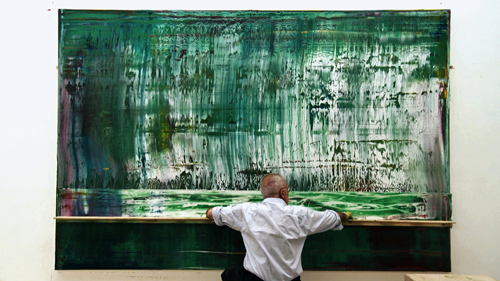Corinna Belz’s 2011 documentary Gerhard Richter Painting is as remarkable for what it doesn’t portray as for what it does. The film focuses on Richter and the people surrounding his art—to the blessed exclusion of talking heads and miscellaneous hangers-on.
A Sisyphean painter

Corinna Belz’s 2011 documentary Gerhard Richter Painting is as remarkable for what it doesn’t portray as for what it does. The film focuses on Richter and the people surrounding his art—to the blessed exclusion of talking heads and miscellaneous hangers-on.
Besides the melody of birdsong echoing quietly through Richter’s studio, the score consists primarily of snippets from John Cage’s 1947 piece for prepared piano, Music for Marcel Duchamp That piece involves single notes—played on a piano whose strings have been tamed with pieces of rubber, weather stripping and a bolt—interspersed with long silences.
These few notes rarely sound. We first hear them as the camera pans slowly across a white wall decked out with a perfect row of Richter’s work.
This shot is repeated later in the film, and the effect, like that of Richter’s large format abstracts, is indescribably alluring. The interplay between bright white wall and colored, erratically-sized canvases tethered together only by an imaginary midline, is a masterful composition of negative and positive space.
The arbitrary placement of items on the strings of a piano is analogous to Richter’s seemingly haphazard smearing of cadmium red, lemon yellow and ultramarine blue across enormous canvases. Inexplicably, it often works. Richter explains that while he can theoretically begin by smearing any color of paint across a canvas, once he’s begun, there is a condition created to which he reacts. This process continues until the artist feels he can do nothing more.
Likewise, Belz begins her film by focusing on Richter in the act of painting, and these scenes form the backdrop onto which others are applied.
And what a gorgeous backdrop it is. Belz uses a handheld camera and a sensitive microphone to follow Richter’s hand as he uses first large brushes, the size that one would use to paint a house, and then large homemade, Plexiglas squeegees to apply layer after layer of hand-mixed and strained paints. We can hear the soft scratch of the brushes and the scrape of the squeegees as the septuagenarian labors like Sisyphus to drag the masses of thick, richly colored paints across the canvases.
We feel a loss when Belz departs from these scenes of artistic labor to flesh out the story of a working artist who must attend to gallery preparations, openings, marketing and other sundry details of the professional’s career. Yet some of these details are fascinating. A scene depicting Richter and his assistants mixing and straining paints through cloth to remove any lumps mesmerizes with its textured, viscous appeal.
Also featured is black-and-white footage of a young Richter explaining his approach to art, which at times seems to contradict his current approach. He almost seems younger now than the serious young man whose work was more political and austere.
Still, part of the appeal of this film lies in how like his subject matter Richter is. A very young 79, he’s solid, sturdy, contemplative and has an easy smile. His current work is chunky and textural, big and vivid, but thoroughly considered.
Belz refers to her approach as “fly-on-the-wall,” but Richter and the hand with the camera regularly converse. This back and forth between the filmmaker and Richter forms a subtle narrative arc. Pay close attention to their dialogue, which reveals a gradual transformation of Richter under the camera’s gaze.
This is easier said than done since the action demands the eye’s full engagement, and because of the caption writers’ unfortunate decision to use small, white subtitles in a film that largely paints with a white palate.
Richter marks the climax of this narrative tension: “It seems hopeless. I don’t think I can do this, painting under observation. That’s…the worst thing there is.” He immediately smiles, walks outside and sits down to breathe. Suffice it to say, things change.
Corinna Belz’s Gerhard Richter Painting (2011)
Friday, April 6, at 7 p.m.
Saturday, April 7, at 4:30 and 7 p.m.
$9 general admission;
$8 Portland Art Museum members, students and seniors




